There may be more than two hundred different species, but only a handful of types of chameleons that make the best pets. They may attract us by their size, appearance, and color, but they have to have certain characteristics that make them compatible with your lifestyle and easier to care for in a home setting. These would make them the best pet chameleon for you.
So instead of randomly choosing just any chameleon and hoping that we get everything right, we have to research different types of chameleons so we’ll know whether or not we can care for a new lizard properly.
To help you pick the best pet chameleon, I’ve narrowed down a few species of chameleons that make great pets for beginner keepers. Read on to learn more about these diverse and fascinating species!
The Best Types of Chameleons to Keep as Pets
Before we go any further, I would first highly recommend choosing a captive bred chameleon as a pet.
Chameleons are easily bred in captivity, and there are no justifiable reasons to take one from its natural habitat.
By purchasing a wild-caught chameleon, you are reducing their natural population, which is already severely depleted due to the destruction of habitat and pollution.
Furthermore, wild-caught chameleons tend to be more susceptible to illnesses than captive-bred chameleons and experience severe stress from the shipping and capture.
Listed below you will find in-depth information on five different chameleons that aren’t difficult to breed and raise in captivity.
These are also some of the most common species of chameleons kept as pets and are suitable for beginner lizard keepers.
Without further ado, let’s help you find a chameleon that suits you and your lifestyle!
Veiled Chameleon
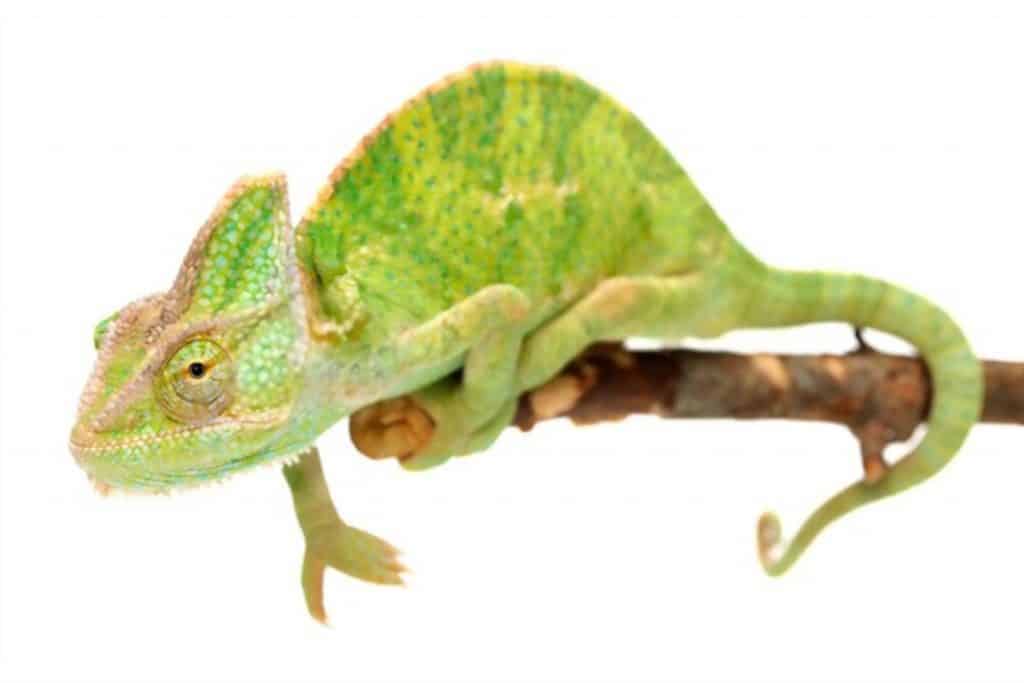
| Prey | Insects, small vertebrates |
| Temperament | Territorial, can become tame |
| Color | Vibrant, can change based on mood |
| Lifespan | 5-7 years (up to 10 with good care) |
| Distinctive Feature | Prominent casque on head |
| Lifestyle | Arboreal, solitary, diurnal |
| Habitat | Yemen, Saudi Arabia, varied habitats |
Native to Yemen and Saudi Arabia, the veiled chameleon makes an awesome pet and is generally considered the best beginner chameleon.
However, it’s important to note that veiled chameleons aren’t a good choice if you are looking for the best lizard for handling, since they are less tolerant to being handled than some other types of chameleons.
While chameleons, in general, aren’t especially fond of handling, veiled chameleons don’t appreciate it one bit.
The great thing about this species is they are almost always captive-bred, which is a huge plus when it comes to pet chameleons. As one of the easiest chameleons to care for, the veiled chameleon tolerates a range of conditions and is a no-fuss eater that will gobble up any insects you throw their way.
The veiled chameleon is also one of the largest species you’ll come across. Males are usually between 17 and 24 inches long from the snout to the tip of the tail. Females are generally shorter, measuring no more than 14 inches long, and tend to have thicker bodies.
This species got its name due to its unusually tall and large head casque that it uses in the wild to steer rainwater into its mouth. Veiled chameleons come in various shades of green with white, yellow, tan, or orange mottling.
Easy to keep and care for, veiled chameleons have an average lifespan of five years for females and eight years for males. Although they are docile and hardy animals, veiled chameleons can become distressed if over-handled, so keep handling to a minimum.
Panther Chameleon
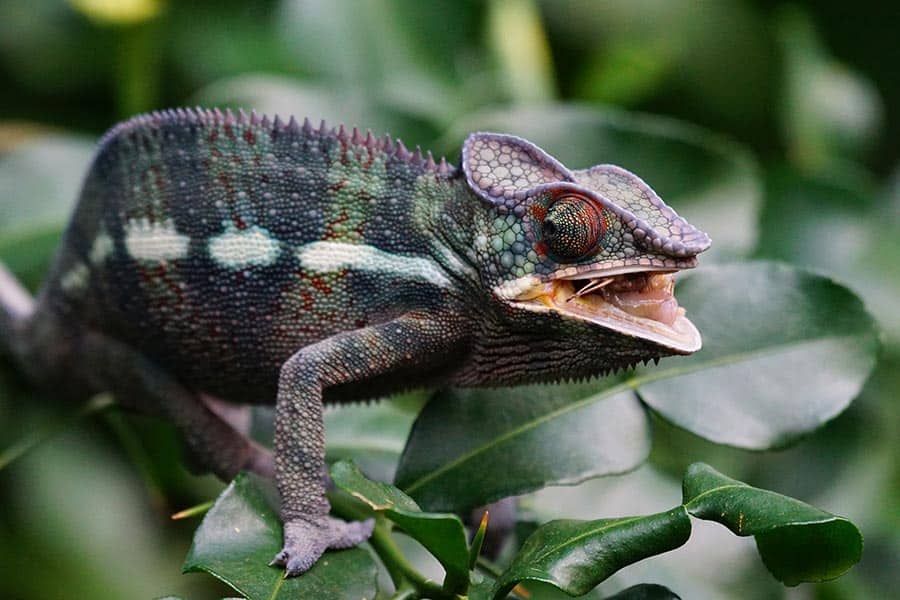
| Prey | Insects, small vertebrates |
| Temperament | Calm, can be defensive when stressed |
| Color | Vibrant, can change based on mood and environment |
| Lifespan | 5-7 years (up to 10 with good care) |
| Distinctive Feature | Large, independently rotating eyes |
| Lifestyle | Arboreal, solitary, diurnal |
| Habitat | Madagascar, rainforests, coastal areas |
Panther chameleons are extremely popular and are one of the best chameleon species for pets. Originating in Madagascar, panther chameleons come in a multitude of vivid colors and patterns that vary with their geographical location, with males ranging from vibrant blue, red, green, or orange. Female panther chameleons, on the other hand, are generally tan and brown with hints of peach, pink, or orange.
Like veiled chameleons, panthers are mostly captive-bred and are also good eaters that don’t discriminate much when it comes to food. Easy to care for and fairly active, panther chameleons don’t mind interaction and are the best chameleon for handling since they tolerate it more than most other species.
Males are significantly larger than females and also more brightly colored. They are also very territorial and prefer to lead a solitary life, so you shouldn’t keep two males in the same enclosure.
Panther chameleons tend to live for around five years and have very specific needs when it comes to their environment.
To keep your panther chameleon healthy, you’ll need to maintain a temperature gradient of 70 to 90°F during the day, with a basking spot that reaches 95°F. Cage temperature may drop during the night at 65 to 70°F, and you should keep their humidity levels around 60 to 80%.
A great pet for beginner keepers, the panther chameleon is a good choice if you want to interact and handle your pet a bit without stressing them out. The only downside is that the panther chameleon is one of the more expensive species, with adults costing around $300.
Oustalet’s Chameleon
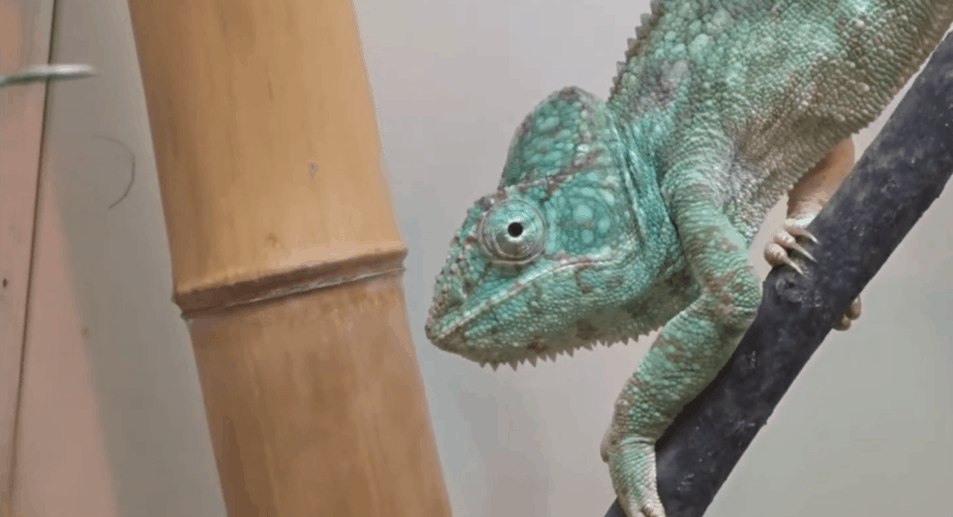
| Prey | Insects, small vertebrates, leaves |
| Temperament | Docile, gentle disposition |
| Color | Variable shades of green, brown |
| Lifespan | 8-12 years (in captivity) |
| Distinctive Feature | Large size, prominent casque |
| Lifestyle | Arboreal, solitary, diurnal |
| Habitat | Madagascar, coastal forests |
Hailing from Madagascar, the Oustalet’s chameleon, also known as the Malagasy Giant chameleon, is one of the largest species of chameleon. They can grow up to 27 inches from head to tail. The Oustalet’s chameleon features a high casque with several ridges and dorsal crests that consist of small triangular spines that run from their neck to the tail.
Although their coloring can vary, most Oustalet’s chameleons are grey or brown, with females being more vibrantly colored than males.
Due to their large size, this species needs a spacious enclosure measuring at least four feet tall, three feet wide, and four feet deep. Except for the larger enclosure, the Oustalet’s chameleon doesn’t have any specific care requirements that set them apart from most other species of chameleons.
This species does well in enclosures with moderate temperature and humidity levels, so try to maintain their enclosure temperature at around 80°F and don’t let the humidity drop below 70%.
The Malagasy giant chameleon prefers a mostly sedentary life and won’t move much unless it’s absolutely necessary. They have a quite passive temperament, with females typically being more receptive to handling than males.
The Oustalet’s chameleon can live for up to 12 years, so make sure you will be able to look after your lizard pet for the entirety of their lifespan. If you are nervous about handling some of the smaller chameleons, this species can be a great choice due to its larger size and robust build.
Jackson’s Chameleon
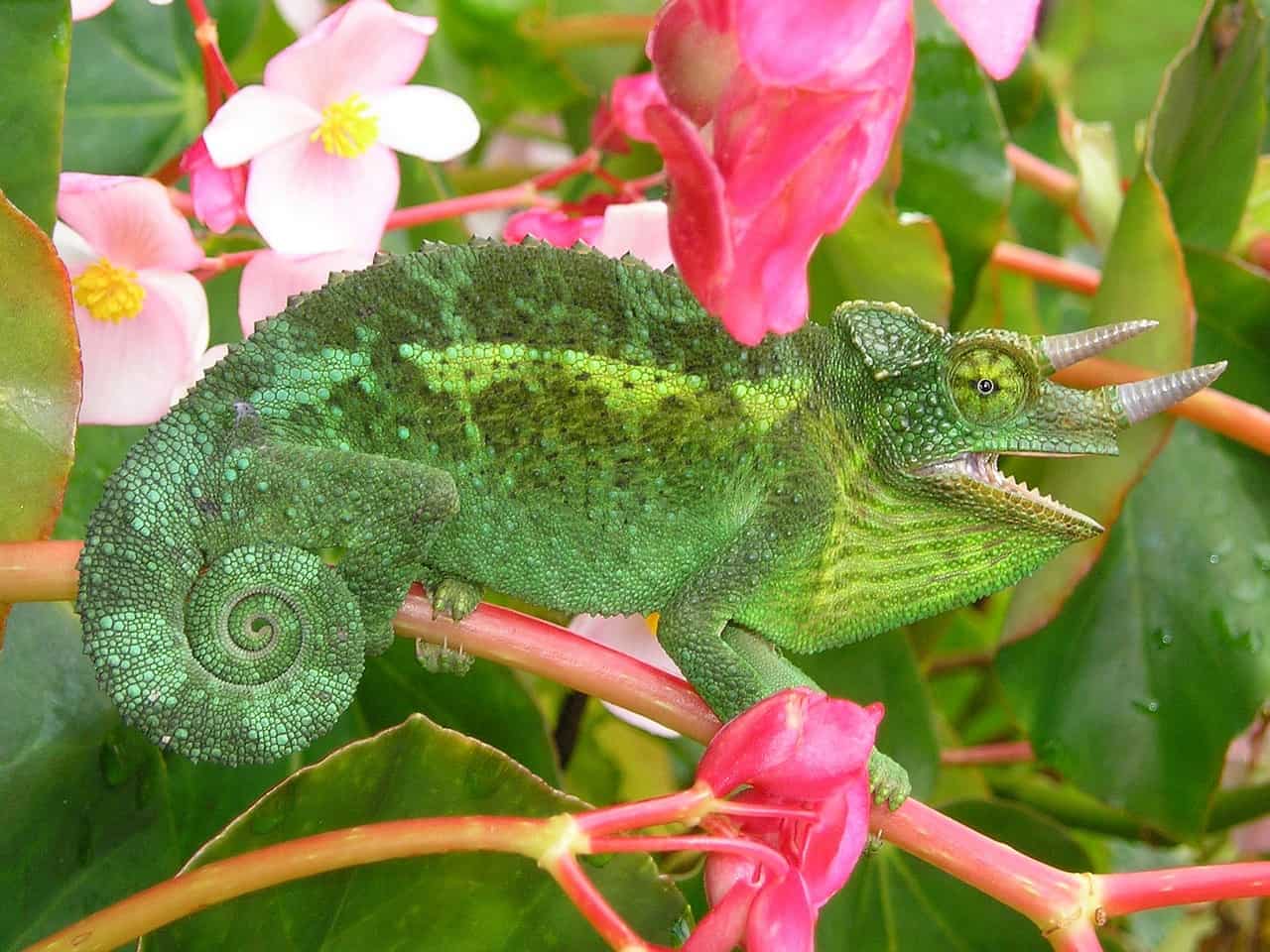
| Prey | Insects, small invertebrates |
| Temperament | Docile, can become defensive |
| Color | Varied, can change based on mood |
| Lifespan | 5-10 years |
| Distinctive Feature | Three horns on head |
| Lifestyle | Arboreal, solitary, diurnal |
| Habitat | Kenya, Tanzania, forested areas |
The first thing you’ll notice about Jackson’s chameleons is the three distinct horns on their heads. Two horns are located on top of the head, while the third one emerges from the nose. While horns are their distinctive trait, only male Jackson’s chameleons have them.
Growing to around 10 to 12 inches long, the Jackson’s chameleon is native to woodlands and forests located in south-central Kenya and northern Tanzania. Still, their small size and horns make them extremely popular and sold in many pet stores across the USA.
Although Jackson’s chameleons are usually green, they come in an array of different shades of green.
Some are green with dark green mottling, some are bright green, others are yellowish, some have vivid blue hues, and others are accentuated with yellowish crests.
These African chameleons generally do well in captivity and will voraciously consume any of the commonly available and used feeder insects. Their diet commonly includes crickets, but they will also eat mealworms, flies, grasshoppers, and roaches.
This species is less territorial than other chameleons, and males generally assert dominance over each other through color displays and posturing. Jackson’s chameleons also have more specific care requirements than other species, which makes them less suitable for first-time keepers.
If you do decide to get one, know that Jackson’s chameleons typically live between 5 and 10 years in captivity, so make sure you’ll be able to care for your pet for the entirety of their lifespan.
Carpet Chameleon
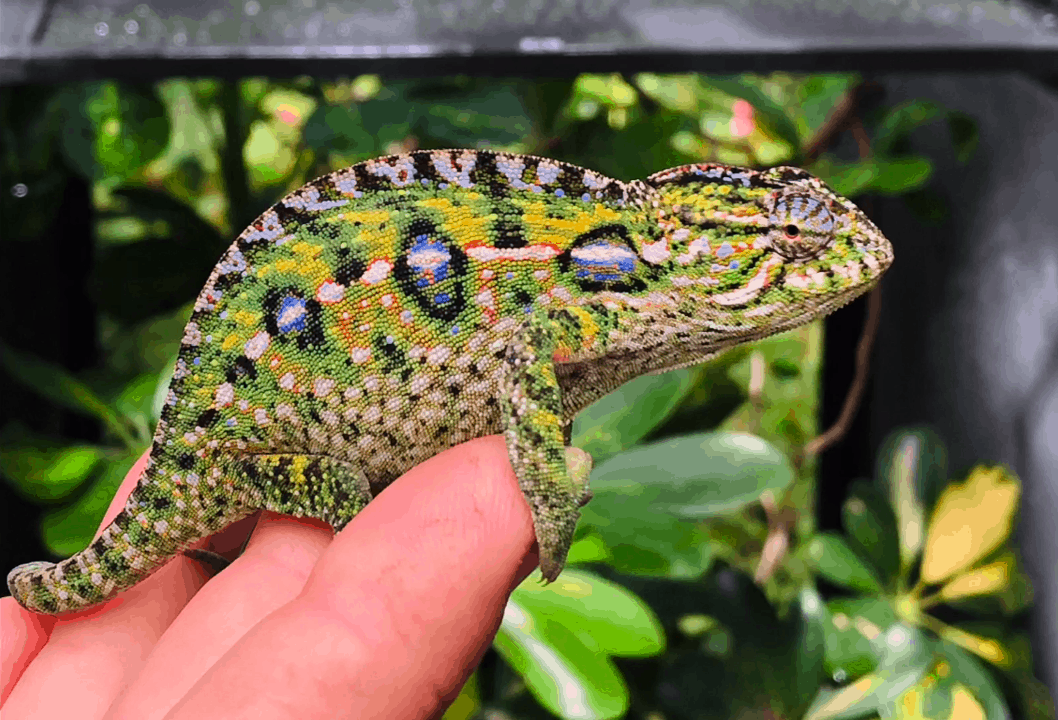
| Prey | Insects, small invertebrates |
| Temperament | Docile, shy, suitable for beginners |
| Color | Variable, can change with mood |
| Lifespan | 2-3 years (up to 5 with good care) |
| Distinctive Feature | Skin pattern and color change |
| Lifestyle | Arboreal, solitary, diurnal |
| Habitat | Madagascar, lowland rainforests |
This species is also commonly known as the jewel chameleon and the white-lined chameleon due to its coloration and markings.
Found around the entirety of Madagascar except for its northern part, the carpet chameleon adapts well to a wide range of habitats like rainforests, areas with high altitudes, and deserts. In captivity, however, they prefer a forest-like environment with lots of lush plants.
Small in size, the carpet chameleon grows to anywhere between 6 and 10 inches and doesn’t need a particularly huge enclosure to stay healthy and thrive. This, combined with the fact that they don’t need any special care, makes this species the best beginner chameleon for first-time keepers.
What they lack in size, they more than compensate in color! Both males and females can have spots, circles, and stripes, but all markings are more pronounced and vivid in female carpet chameleons. The fact that females are more colorful and ornate than male carpet chameleons is rather unique in the animal world and makes this species truly special.
Carpet chameleons also enjoy being handled and are a great choice if you are looking for a small chameleon that won’t mind some interaction.
Because they are generally timid and shy, carpet chameleons usually need some time to warm up to their owners and start being receptive to hand feeding and holding.
FAQs on Chameleon Species
Do chameleons make good pets?
If you are wondering if a chameleon is a good pet, rest assured, because chameleons are amazing animals that make great pets. However, chameleons aren’t for everyone, and before you decide to purchase one, you should research the many different species of chameleons and their unique care requirements.
Veiled chameleons, Jackson’s chameleons, and panther chameleons are some of the most popular species kept as pets. They generally don’t have any specific requirements or hard-to-meet needs, and they aren’t picky with their food. With that being said, chameleons generally aren’t a good choice if you haven’t owned lizards before.
What is the easiest pet chameleon?
The veiled chameleon is an extremely popular species of chameleon, especially with beginner keepers. Although they don’t like to be handled, veiled chameleons don’t have any specific care or nutritional requirements and are one of the easiest species to keep in captivity.
They are also mostly captive-bred, which is always a better option than wild-caught chameleons. Another great thing about veiled chameleons is they aren’t picky with their food and will eat any insects you choose to feed them.
Do chameleons like to be held?
Most chameleons don’t like to be held or petted. However, it is possible to pick up and hold a chameleon for short periods of time, and most won’t become aggressive or try to bite you while you handle them. Still, chameleons have sensitive skin and bodies, so any amount of touching can cause them discomfort and stress.
Although some species of chameleons will allow being held and are more tolerant of handling, none of them actually enjoy it. Therefore, you should avoid being overly touchy with your chameleon and let them do their thing.
If your chameleon wants to be held, they will come to your hand and allow you to hold them and even pick them up and carry them out of the cage.
Ready for a Pet Chameleon?
There are many different species of chameleons, some of which make better pets for both beginner and experienced owners.
If you’ve never owned a chameleon before, take your time and research various species to find what is the best chameleon to have as a pet for your own life.
Like all other pets, chameleons can be a big responsibility depending on which species you decide to keep. Luckily, some species are easier to take care of than others and are more suitable for first-time keepers.
All species of chameleons listed in this article are a great choice whether you are a novice or experienced owner, provided you are willing to properly care for them and meet their specific needs.
Each species has a distinct appearance, temperament, and is unique in its own way, but all of them make great pets and are fairly easy to care for.
Before you make a decision and welcome a chameleon into your home, do some research to understand the unique habitat requirements and other care needs of your new pet.
Making sure your pet chameleon has everything it needs will ensure that they stay healthy and happy in their new home for years to come.

